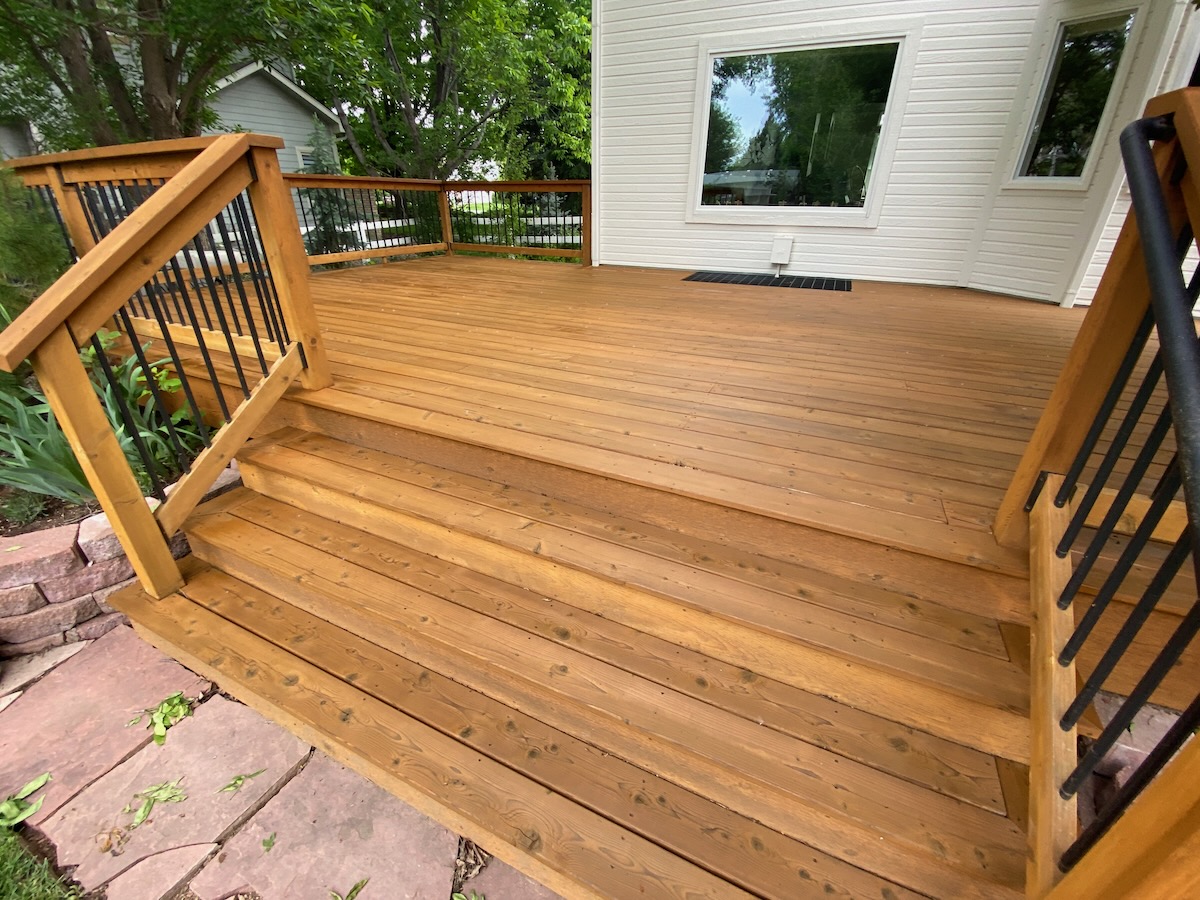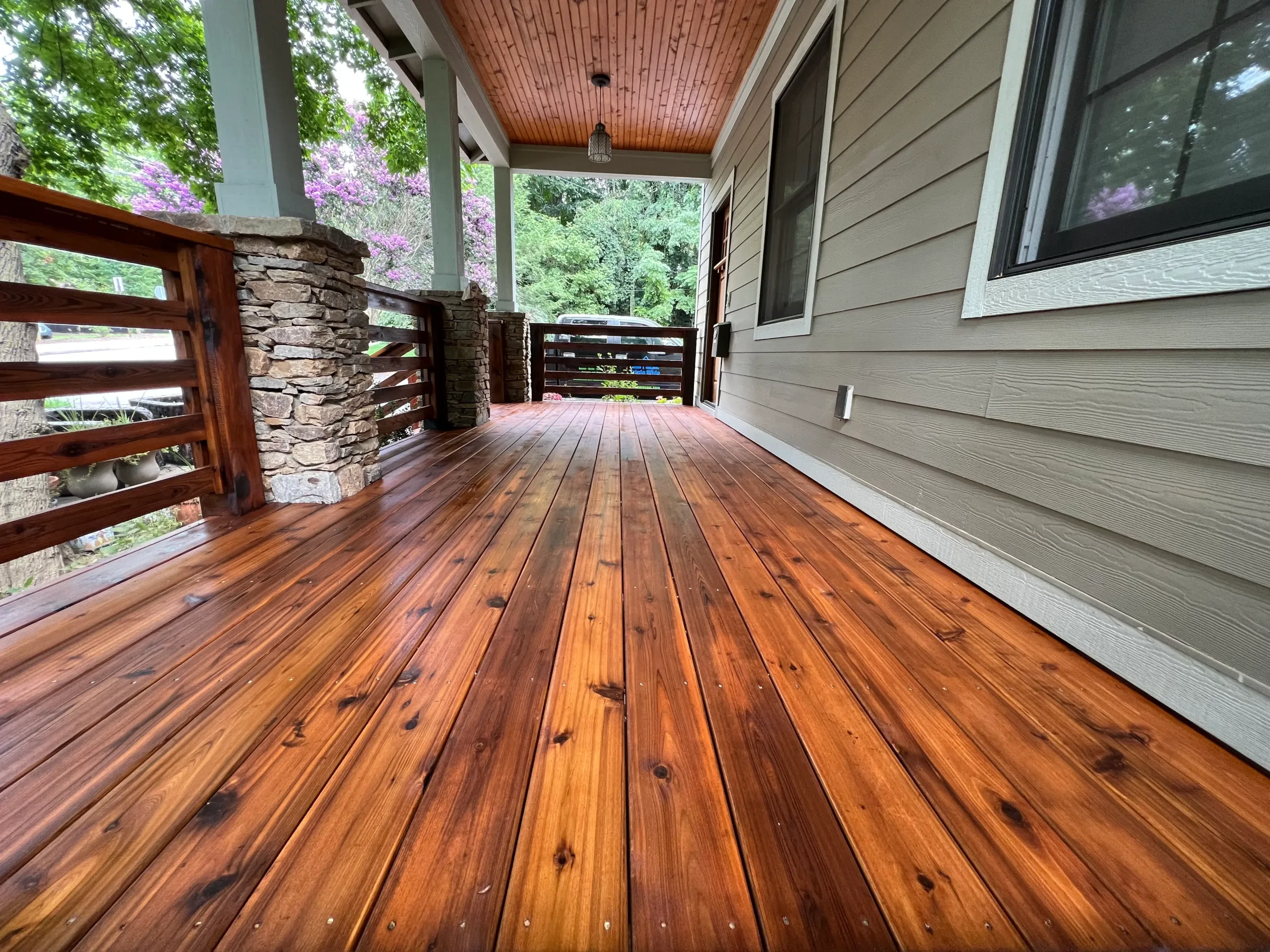Choosing the Right Deck Stain: Enhance and Shield Your Deck
Wiki Article
A Comprehensive Overview to Various Kinds Of Deck Staining Techniques for Ultimate Protection and Looks
In the realm of deck upkeep, the art of discoloring stands as a critical step in the direction of both protecting the honesty of your outside space and boosting its visual appeal. As we navigate through the elaborate globe of deck staining techniques, one starts to appreciate the nuanced strategies that can make all the difference between a mediocre surface and a flawless one.Recognizing Different Kinds of Stains
Various types of stains are commonly made use of in the process of deck discoloration to attain different visual and safety results. On the other hand, semi-transparent stains use a balance in between shade improvement and protection, allowing some wood grain to show through.Additionally, there are likewise specialized spots such as printer toners and sealants. Toners include a tip of color to the wood while supplying marginal defense, making them ideal for more recent decks with less wear. Sealers, on the other hand, offer security against wetness and UV rays without adding color, making them a preferred choice for decks that currently flaunt a desirable shade. Understanding the qualities and benefits of each kind of discolor is crucial for accomplishing the preferred look and durability for your deck.
Selecting the Right Spot Shade
When taking into consideration the aesthetic appeals of your deck discoloration job, the option of stain shade plays a vital role in boosting the safety top qualities of the selected tarnish type (Right Deck Stain). The color you choose can substantially impact the total look of your deck, as well as its capacity to endure the aspects with timeWhen choosing a stain color, it's important to consider the existing color design of your home's exterior. Integrating the deck tarnish with the total visual of your residential property can produce a visually appealing and natural exterior area. Additionally, the shade of your deck discolor can affect the temperature level of the deck surface; darker colors often tend to soak up more heat, while lighter shades show sunlight and remain cooler.
Furthermore, the kind of wood you are discoloring will certainly also affect exactly how the tarnish color appears. Various timber species can interact with the tarnish in various methods, possibly modifying the final shade. It's a good idea to test the discolor on a tiny, low-profile area of the deck to make sure the shade turns out as preferred prior to continuing with the entire job.
Preparing Your Deck for Discoloration
To make certain a successful and lasting deck staining job, extensive prep work of the deck surface area is essential. Begin by cleaning the deck thoroughly to eliminate dust, crud, mold, and any kind of old end up or stain. Make use of a deck cleaner or a mix of water and detergent in addition to a rigid brush or stress washing machine to scrub the surface area clean. After cleansing, allow the deck to completely dry entirely prior to going on to the following action.Examine the deck for any damaged or rotten boards that need to be replaced. Hammer down any kind of extending nails and sand helpful hints any type of rough locations to ensure a smooth surface for discoloration. Look for any type of loose barriers or steps that may need tightening up or repair work.
Once the deck is tidy, dry, and in excellent repair work, consider using a wood brightener to bring back the deck's natural color and open up the timber pores for much better tarnish penetration. Protect any type of neighboring plants, furniture, or surfaces with plastic sheet prior to proceeding with the discoloration procedure. Correct preparation is crucial to achieving a professional-looking surface and optimizing the longevity of your deck discolor.
Using Spot With Numerous Techniques
For a professional and flawless surface, the approach of applying discolor plays an essential function in boosting the look and resilience of your deck. There are a number of strategies you can make use of to make certain an effective application of tarnish.Brushing is a standard approach that permits accuracy and control over the amount of stain applied. It is suitable for detailed areas and reaching between deck boards (Chicago Deck Staining). Rolling is a quicker option, covering bigger area successfully. However, back-brushing after rolling is suggested to also out the discolor and function it into the wood for far better penetration.
Spraying is another popular technique, offering rate and convenience of application, specifically for big deck areas. It is very important to use a premium sprayer and bear in mind overspray. Pad applicators offer a smooth and even end up and click here to find out more are appropriate for both vertical and straight surfaces. Whichever technique you pick, making sure appropriate preparation and adhering to supplier standards will aid attain a long-lasting and attractive discolor finish on your deck.

Maintaining and Re-staining Your Deck
When it comes to re-staining your deck, the regularity depends on different factors such as the kind of stain made use of, the climate in your location, and how much wear and tear your deck experiences. Normally, it is recommended to re-stain your deck every 2-4 years to keep its security and aesthetics.Prior to re-staining, guarantee the deck is tidy, Recommended Site completely dry, and cost-free of any type of previous tarnish deposit. Choose a top notch stain that fits your deck's material and supplies the preferred degree of security.
Final Thought
To conclude, recognizing the different kinds of deck stains, choosing the right color, properly preparing the deck, applying tarnish with numerous techniques, and re-staining the deck and maintaining are essential steps for best defense and aesthetics. By following these steps, you can make certain that your deck continues to be in leading condition for years to come.In addition, the color of your deck discolor can influence the temperature of the deck surface; darker colors have a tendency to absorb more warmth, while lighter colors mirror sunlight and remain cooler.
It's suggested to examine the stain on a small, unnoticeable area of the deck to make sure the color turns out as wanted before proceeding with the whole job.

Report this wiki page